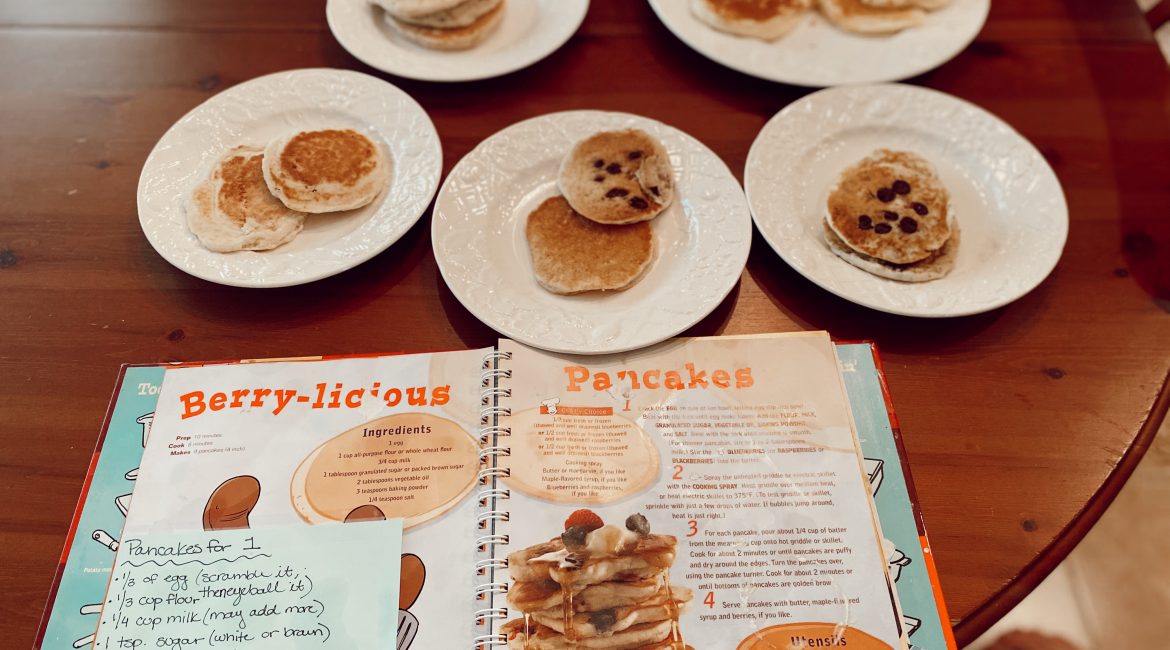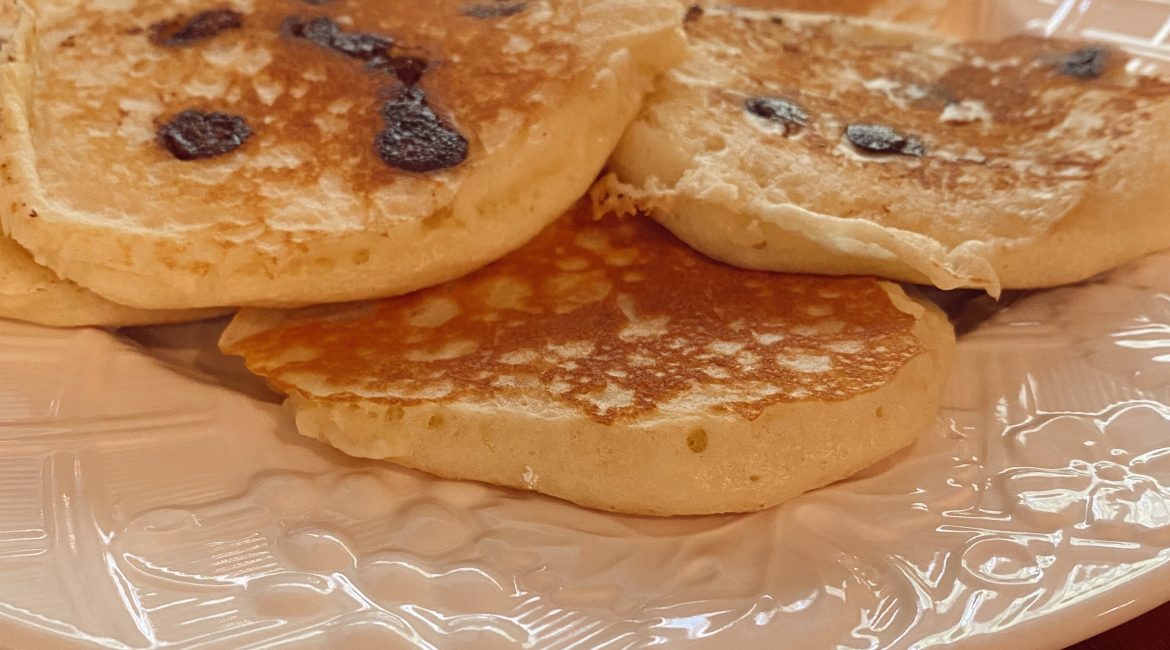When I was six, my dad bought my mom a Betty Crocker’s Kids Cookbook for mother’s day with the idea that us kids, myself and three younger siblings, would cook one meal a month for her, by ourselves, as a treat. All these years later, the only recipe that has been touched in that book is on page 13: “Berry-Licious” (which we’ve now converted to Chocolate Chip) Pancakes. After using that recipe once, my family has never gone back to using boxed pancake batter. Now, homemade pancakes are a staple at our kitchen table on Saturday mornings, at least when I am home!
However, I often times run into a problem when I go to get to the fridge to get the one large egg the recipe calls for and that is that probably 4 times out of 10, we are fresh out of eggs. My family doesn’t use eggs much besides in baking and its not something that is on my mom’s weekly grocery list. So there have been times when we are out of eggs, my neighbor is out of eggs and my favorite Saturday breakfast is no longer an option to make.
With this food blog project, I am going to try out three different substitutes for that one egg in the recipe that will not drastically change the consistency or flavor of my beloved homemade pancakes!
Science Behind Pancakes:
Egg; when mixed with the gluten in flour and milk, the gluten molecules get more flexible and can bind to each other to form networks, trapping carbon dioxide, also provides more protein (Andrew 2019). Both egg whites and egg yolks, when whipped, trap air with denatured proteins that form a mesh like structure around the air bubbles created by whipping or mixing. (Potter 2015). Eggs play an important role in holding the pancake together as well.
Flour is the source of gluten in baked goods. Gluten is made up of two proteins, glutenin and gliaden, and when combined with a liquid, the gluten molecules stick to each other and form a “strechy” membrane that traps in air bubble created by leaving agents (Potter 2015).
Sugar has two functions in pancakes, the first of which is to add tenderness and sweetness (Bhatia 2017) The second is the process known as Maillard Reaction; sugars react with amino acids, generating a “wide range of small molecules that escape from the mixture” (Andrew 2019) and are responsible for the classic pancake aroma and toasty brown coloring we know and love.
Baking Powder is the main leavening agent in pancakes; it essentially fills the gluten in flour with air (Bhatia 2017). The bicarbonate as well as acidic ingredient in baking powder reacts with liquids to release carbon dioxide, air bubbles, into the batter. Baking powder is double acting which means it gives out another round of bubbles after heating (Bahtia 2017). Essentially, double acting baking powder uses both slow and fast acting acids to help prevent collapsed baked good (Potter 2015).
Salt is used mainly for taste. Adding a tiny bit of salt to a baked good such as a pancake can help to even out any sourness and enhance sweetness, rather than make it taste “salty” (Potter 2015).
Milk provides moisture to the batter, thinning it out, as well as a reacts with the baking soda to instigate leavening (Bhatia 2017).
Oil the fat in pancakes, at plays an important role in adding tenderness to baked goods by coating flour to act as a barrier between proteins and water ultimately slowing down gluten development. The main function of oils in baking is to add richness and tenderness as they do not solidify once cooled (Bettie 2019).
Three substitutes for eggs:
- Applesauce click here
- Chia Seeds click here
- Neat Egg click here
Ingredients
Instructions
- In medium bowl, beat egg with wire whisk until fluffy. Stir in remaining ingredients just until flour is moistened (batter will be slightly lumpy); do not overmix or pancakes will be tough. For thinner pancakes, stir in additional 1 to 2 tablespoons milk.
- Heat griddle or skillet over medium-high heat (375°F). (To test griddle, sprinkle with a few drops of water. If bubbles jump around, heat is just right.) Brush with vegetable oil if necessary (or spray with cooking spray before heating). For each pancake, pour slightly less than 1/4 cup batter onto griddle. Cook 2 to 3 minutes or until bubbly on top and dry around edges. Sprinkle on chips. Turn; cook other side until golden brown.
- For each pancake, pour slightly less than 1/4 cup batter onto griddle. Cook 2 to 3 minutes or until bubbly on top and dry around edges. Sprinkle on chips.
- Turn; cook other side until golden brown.
Notes
Andrew. (2019, March 11). The Science Behind Making A Perfect Pancake. Retrieved April 30, 2020, from https://www.iflscience.com/chemistry/science-behind-making-perfect-pancake/
Bhatia, A. (2017, June 03). Pancakes, served with a side of science. Retrieved April 30, 2020, from https://www.wired.com/2012/07/pancakes-served-with-a-side-of-science/
Facebook.com/bakerbettie. (2019, December 31). All About Fat and its Function in Baking. Retrieved from https://bakerbettie.com/function-of-fat-in-baking/
Potter, J. (2015). Cooking for geeks: Real science, great cooks, and good food. Sebastopol, CA: O'Reilly Media.
Bridenstine, S. (2019, August 04). Why Is Applesauce a Good Substitute for Eggs? Retrieved April 30, 2020, from https://wigglywisdom.com/why-is-applesauce-a-good-substitute-for-eggs/
Michaelis, Shannon, Wood, K., Scott, Kristen, Michelle, . . . Facebook. (2019, December 23). How to Make an Egg Substitute with Chia Seeds. Retrieved April 30, 2020, from https://www.foodrenegade.com/how-make-egg-substitute-chia-seeds/
Neat – The Neat Egg Substitute. (n.d.). Retrieved April 30, 2020, from https://atlanticnaturalfoods.com/dima-portfolio/neat-the-neat-egg-substitute/
All photos/pictures taken and owned by author.


